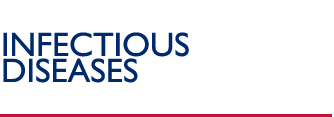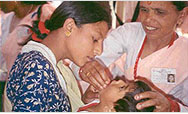Central Asian Republics
Among the Central Asian Republics (CAR), which comprises Kazakhstan, Kyrgyzstan,
Tajikistan, Turkmenistan, and Uzbekistan, it is Tajikistan that has the highest
tuberculosis (TB) incidence rate. According to the World Health Organization’s
(WHO’s) Global TB Report 2008, Tajikistan has an estimated 204 cases per 100,000
population, and had the highest mortality rate of 39 per 100,000 population in 2006.
Although there have been impressive gains in TB control and prevention, much remains
to be done to reduce the threat of this serious infectious disease in the region.
Between 1991 and 2001, the number of reported TB cases in the region increased
drastically, especially in prison populations. Since 2001, reported cases have declined in
Kyrgyzstan and Kazakhstan but have continued to increase, along with DOTS (the
internationally recommended strategy for TB control) expansion, in Tajikistan,
Turkmenistan, and Uzbekistan. Multidrug-resistant (MDR) TB has become a serious
problem. The fourth Anti-Tuberculosis Drug Resistance in the World report in 2008
identified Tajikistan as having the third highest proportion of MDR-TB globally (16
percent of newly diagnosed cases). Kyrgyzstan has the sixth highest proportion, with
14.7 percent MDR-TB among newly diagnosed cases. HIV prevalence among TB
patients remains low, at less than 1.0 percent in all countries.
TB trends and indicators in the CAR reflect the deterioration of health care systems
and increased poverty since the breakup of the Soviet Union in the early 1990s. This
breakup facilitated the spread of infectious diseases, including TB and MDR-TB, in many
former Soviet republics. The newly independent CAR were unable to sustain the
previous TB infrastructure and are in need of new solutions to combat the growing TB
problem. Labor migration from Kyrgyzstan, Tajikistan, and Uzbekistan to Kazakhstan
and Russia is possibly fueling the epidemics, but real prevalence among this risk group is
unknown. Other system challenges include poor TB infection control; weak integration
between civic and prison systems, ambulatory and inpatient services, and TB-HIV
services; as well as a lack of social support for TB patients. Case detection has steadily
improved under DOTS in all countries except for Kazakhstan, where estimated
incidence is also declining, but none has reached the WHO target of 70 percent.
Uzbekistan reached 48 percent case detection rate, but Tajikistan only reached 33
percent. Turkmenistan, Kyrgyzstan, and Tajikistan have reached the 85 percent target
for DOTS treatment success rate, although Turkmenistan slipped slightly from 86
percent in 2005 to 81 percent in 2006. Uzbekistan’s treatment success rate has
remained around 80 percent over the past four years, while Kazakhstan has seen
declines in treatment success and case detection rates since 2002. Kazakhstan has the
highest failure rate among new sputum smear positive (SS+) cases in the 2005 cohort,
at 14 percent, while Uzbekistan has the highest default rate, especially among SS+ re-
treatment cases in the 2005 cohort, at 15 percent. According to Default from
Tuberculosis Treatment in Tashkent, Uzbekistan, a published study conducted by Project
HOPE in Uzbekistan, the defaulter rate among all SS+ and SS negative cases in the 2005
cohort in Tashkent was 21 percent.
USAID Approach and Key Activities
Since 1998, USAID has supported the fight against TB in the CAR by helping the governments of these countries implement DOTS. USAID activities for TB control and prevention in the CAR now cover more than 50 percent of the total population. USAID has launched a five-year, $15 million TB control program to strengthen surveillance, laboratory quality, and rational drug management in the region’s reforming health care systems. USAID has worked regionally to facilitate the creation of multisectoral high-level working groups that coordinate TB control activities in a range of priority areas, including DOTS expansion, drug management, prison health systems, management of TB-HIV/AIDS co-infection, and MDR-TB. In fiscal year 2007, USAID funding for TB programming in the CAR totaled more than $4.5 million for the five countries. USAID assistance includes support for the following activities:
- Supporting development of TB infection control strategies in all five countries in the region
- Strengthening National TB Control Program (NTCP) management in all countries
- Increasing the human resources capacity to respond to the TB epidemic in Central Asia
- Building capacity to address MDR-TB and TB-HIV/AIDS co-infection
- Advocating for government support for the inclusion of TB in national health budgets, including funding for capacity building of the NTCP
- Building better information and logistics systems
- Improving laboratory networks through external quality assurance systems
- Supporting community advocacy and mobilization, including developing national behavior change communication strategies for the general population and risk groups
- Developing approaches to bring DOTS to special populations (e.g., prisoners) and strengthening civilian sector linkages for TB control
USAID Program Achievements
USAID support has improved the capacity to implement DOTS region-wide. Achievements include:
- Improved political support to the NTCPs in the region
- Assisted in developing proposals for grants from the Global Fund to Fight AIDS, Tuberculosis and Malaria
- Implemented an electronic surveillance and case management system in all countries and trained specialists on the system
- Introduced laboratory quality assurance system for smear microscopy
- Improved the logistics management information system for drug management in all republics of the region.
- Provided technical assistance to countries in their applications to the Global TB Drug Facility, which enabled pediatric anti-TB drugs to become available to all countries in the region – with the exception of Uzbekistan – for the first time
- Implemented a small grants program in Tajikistan, Kazakhstan, and Kyrgyzstan to build capacities of civil societies to control TB and to expand the reach of information throughout the countries, resulting in more than 10,000 schoolchildren in Kyrgyzstan being reached with TB prevention education
- Improved the integration of TB control activities into primary health care (PHC) and updated a six-month PHC retraining curriculum with essential TB-DOTS topics
- Supported training region-wide since 1997, in collaboration with the Global Fund, for 5,080 TB specialists, 6,957 PHC staff, 1,151 laboratory staff, and 6,251 other health staff
- Equipped the TB laboratory and trained medical specialists in one district in Turkmenistan and provided educational materials and equipment for a new national training center
- Equipped the national laboratories in Tajikistan and Turkmenistan and a laboratory in Karaganda, Kazakhstan
- Improved management of TB-HIV/AIDS co-infection through collaboration of services in four countries
- Developed a successful model for case management of MDR-TB in Almaty City, Kazakhstan, which facilitated development of 12 standard protocols on various components of MDR-TB management, including diagnosis, treatment,
and direct observation of drug use protocols, which are now institutionalized for nationwide use and will be used as a
best practice example for regional scale-up
Partnerships
USAID is the leading donor supporting DOTS implementation in the CAR. USAID’s partners include CAR national governments, the Project HOPE Consortium (Project HOPE, the Johns Hopkins University’s Center for Communication Programs, the New Jersey Medical School Global Tuberculosis Institute, and John Snow, Inc.), WHO, the U.S. CDC, Abt Associates, Management Sciences for Health, the Gorgas TB Initiative, the KNCV Tuberculosis Foundation, and Catholic Charities. The Global TB Drug Facility has provided first-line drugs to Tajikistan and Uzbekistan. The Global Fund provided Round 6 grants to Kyrgyzstan for $4.2 million and to Tajikistan for $6.5 million to enhance DOTS implementation and strengthen the NTCPs. For Round 8, only Uzbekistan, Kazakhstan, and Tajikistan have been approved for $55.5 million, $77.5 million, and $12 million, respectively, for the next five-year program (2009–2014), which will mostly address MDR-TB.
March 2009
Related Links
|


